Results for “police prisons” 22 found
Police versus Prisons
Here’s a remarkable graph from the Council of Economic Advisers report on incarceration and the criminal justice system. The graph shows that the United States employs many more prison guards per-capita than does the rest of the world. Given our prison population that isn’t surprising. What is surprising is that on a per-capita basis we employ 35% fewer police than the world average. That’s crazy.
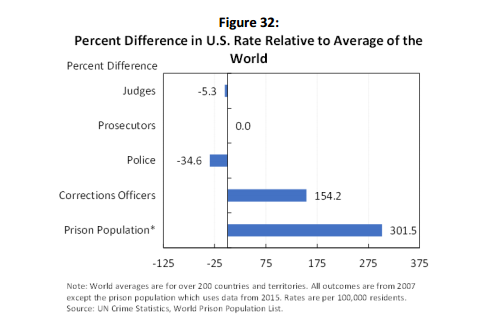
Our focus on prisons over police may be crazy but it is consistent with what I called Gary Becker’s Greatest Mistake, the idea that an optimal punishment system combines a low probability of being punished with a harsh punishment if caught. That theory runs counter to what I have called the good parenting theory of punishment in which optimal punishments are quick, clear, and consistent and because of that, need not be harsh.
We need to change what it means to be “tough on crime.” Instead of longer sentences let’s make “tough on crime” mean increasing the probability of capture for those who commit crimes.
Increasing the number of police on the street, for example, would increase capture rates and deter crime and by doing so it would also reduce the prison population. Indeed, in a survey of crime and policing that Jon Klick and I wrote in 2010 we found that a cost-benefit analysis would justify doubling the number of police on the street. We based our calculation not only on our own research from Washington DC but also on the research of many other economists which together provide a remarkably consistent estimate that a 10% increase in policing would reduce crime by 3 to 5%. Using our estimates, as well as those of some more recent papers, the Council of Economic Advisers also estimates big benefits (somewhat larger than ours) from an increase in policing. Moreover, what the CEA makes clear is that a dollar spent on policing is more effective at reducing crime than a dollar spent on imprisoning.
Unfortunately, selling the public on more policing is likely to be difficult. Some of the communities most in need of more police are also communities with some of the worst policing problems. We aren’t likely to get more policing until people are convinced that we have better policing. Moreover, people are right to be skeptical because the type of policing that works is not simply boots on the ground. As the CEA report notes:
Model policing tactics are marked by trust, transparency, and collaborations between police and community stakeholders…
Better policing and more policing complement one another. Greater trust can come with body cameras as well as community oversight and other efforts to bring transparency and accountability. Most importantly, the drug war has eroded trust between police and community and that has led to an endogenous equilibrium in which some communities are rife with both drugs and crime. Fortunately, marijuana decriminalization and legalization have begun to move resources away from the war on drugs. Legalization in states like Colorado does not appear to have increased crime and has likely contributed to a dramatic decline of violence in Mexico. As we move resources away from drug crime, police will have more resources to raise the punishment rate for those traditional crimes like murder, robbery and rape that communities everywhere do want punished.
Addendum: See also Peter Orszag’s column on this issue.
More Police, Fewer Prisons, Less Crime
The New York times as a good piece on prisons, police and crime:
“The United States today is the only country I know of that spends more on prisons than police,” said Lawrence W. Sherman, an American criminologist on the faculties of the University of Maryland and Cambridge University in Britain. “In England and Wales, the spending on police is twice as high as on corrections. In Australia it’s more than three times higher. In Japan it’s seven times higher. Only in the United States is it lower, and only in our recent history.”
…Dr. Ludwig and Philip J. Cook, a Duke University economist, calculate that nationwide, money diverted from prison to policing would buy at least four times as much reduction in crime. They suggest shrinking the prison population by a quarter and using the savings to hire another 100,000 police officers.
My work on policing in Washington, DC (with Jon Klick) also strongly suggests that more police pass the cost benefit test; we suggest that doubling the police force would not be unreasonable.
Underpoliced and Overprisoned, revisited
I’ve been writing for years that the United States is underpoliced and overprisoned. Time for a review:
NYTimes: “The United States today is the only country I know of that spends more on prisons than police,” said Lawrence W. Sherman, an American criminologist on the faculties of the University of Maryland and Cambridge University in Britain. “In England and Wales, the spending on police is twice as high as on corrections. In Australia it’s more than three times higher. In Japan it’s seven times higher. Only in the United States is it lower, and only in our recent history.”
…Dr. Ludwig and Philip J. Cook, a Duke University economist, calculate that nationwide, money diverted from prison to policing would buy at least four times as much reduction in crime. They suggest shrinking the prison population by a quarter and using the savings to hire another 100,000 police officers.
Here’s a graph from Daniel Bier on the ratio of police to prison spending comparing the United States to Europe. The US spends relatively less on police and more on prisons than any European country.

And here’s a graph from President Obama’s CEA report on incarceration and the criminal justice system. The graph shows that the United States employs many more prison guards per-capita than does the rest of the world. Given our prison population that isn’t surprising. What is surprising is that on a per-capita basis we employ 35% fewer police than the world average. That’s crazy.

Our focus on prisons over police may be crazy but it is consistent with what I called Gary Becker’s Greatest Mistake, the idea that an optimal punishment system combines a low probability of being punished with a harsh punishment if caught. That theory runs counter to what I have called the good parenting theory of punishment in which optimal punishments are quick, clear, and consistent and because of that, need not be harsh.
Increasing the number of police on the street, for example, would increase capture rates and deter crime and by doing so it would also reduce the prison population. Indeed, in a survey of crime and policing that Jon Klick and I wrote in 2010 we found that a cost-benefit analysis would justify doubling the number of police on the street. We based our calculation not only on our own research from Washington DC but also on the research of many other economists which together provide a remarkably consistent estimate that a 10% increase in policing would reduce crime by 3 to 5%. Using our estimates, as well as those of some more recent papers, the Council of Economic Advisers also estimates big benefits (somewhat larger than ours) from an increase in policing. Moreover, what the CEA makes clear is that a dollar spent on policing is more effective at reducing crime than a dollar spent on imprisoning.
Can we increase the number of police? Not today but in recent years large majorities of blacks, hispanics and whites have said that they support hiring more police. It is true that blacks are more skeptical than whites of police and have every reason to be. Some of the communities most in need of more police are also communities with some of the worst policing problems. Better policing and more policing, however, complement one another. Demilitarize the police, end the war drugs, regulate people less, restrain police unions and eliminate qualified immunity so that police brutality can be punished and the bad apples removed and the demand for police will soar.
As we reform and unbundle policing let us remember that lower crime has been one of the greatest benefits to African American men over the past 30 years.
…the most disadvantaged people have gained the most from the reduction in violent crime.
Though homicide is not a common cause of death for most of the United States population, for African-American men between the ages of 15 and 34 it is the leading cause, which means that any change in the homicide rate has a disproportionate impact on them. The sociologist Michael Friedson and I calculated what the life expectancy would be today for blacks and whites had the homicide rate never shifted from its level in 1991. We found that the national decline in the homicide rate since then has increased the life expectancy of black men by roughly nine months.
…The everyday lived experience of urban poverty has also been transformed. Analyzing rates of violent victimization over time, I found that the poorest Americans today are victimized at about the same rate as the richest Americans were at the start of the 1990s. That means that a poor, unemployed city resident walking the streets of an average city today has about the same chance of being robbed, beaten up, stabbed or shot as a well-off urbanite in 1993. Living in poverty used to mean living with the constant threat of violence. In most of the country, that is no longer true.
More police on the street is one cause, among many, of lower crime. Chicago just had a horrendous day with 18 innocent people murdered in mostly random drive-by shootings, in part because the police were occupied with protests and riots. As we reform, unbundle, and reimagine, let’s be careful not to reverse nearly thirty years of falling crime which has produced a tremendous increase in the standard of living of the poorest Americans.
We need better policing so that we can all be comfortable with more policing.
The United States is Underpoliced and Overprisoned
Daniel Bier has a nice rundown on the ratio of police to prison spending comparing the United States to Europe. The US spends less on police and more on prisons than any European country.

Moreover, this is not because Europe spends less on criminal justice. Surprisingly, there is very little correlation between total spending and the ratio of police to prison spending. What we see in the graph below, for example, is that Europe is on the right, indicating more police to prison spending but not noticeably below the US states on total spending as a percent of GDP.

As I have argued before, the United States is underpoliced and overprisoned.
Crime Imprisons and Kills
…the most disadvantaged people have gained the most from the reduction in violent crime.
Though homicide is not a common cause of death for most of the United States population, for African-American men between the ages of 15 and 34 it is the leading cause, which means that any change in the homicide rate has a disproportionate impact on them. The sociologist Michael Friedson and I calculated what the life expectancy would be today for blacks and whites had the homicide rate never shifted from its level in 1991. We found that the national decline in the homicide rate since then has increased the life expectancy of black men by roughly nine months.
…The everyday lived experience of urban poverty has also been transformed. Analyzing rates of violent victimization over time, I found that the poorest Americans today are victimized at about the same rate as the richest Americans were at the start of the 1990s. That means that a poor, unemployed city resident walking the streets of an average city today has about the same chance of being robbed, beaten up, stabbed or shot as a well-off urbanite in 1993. Living in poverty used to mean living with the constant threat of violence. In most of the country, that is no longer true.
That’s Patrick Sharkey writing in the New York Times.
More police on the street is one cause, among many, of lower crime. It’s important in the debate over better policing that we not lose sight of the value of policing. Given the benefits of reduced crime and the cost of police, it’s clear that U.S. cities are under policed (e.g. here and here). We need better policing–including changes in laws–so that we can all be comfortable with more policing.
Police, Crime and the Usefulness of Economics
In 1994 the noted criminologist David Bayley wrote:
The police do not prevent crime. This is one of the best kept secrets of modern life. Experts know it, the police know it, but the public does not know it.
Economists were skeptical based on intuition but in truth the empirical work from economists at that time was mixed with some papers showing little or no effect of police on crime, just as Bayley argued. Since Levitt’s pioneering paper, however, there have been many papers applying a wide variety of more credible research designs like natural experiments, regression discontinuity, matching and other techniques. Any one of these papers is subject to criticism but as group the results have been remarkably consistent: police reduce crime with a 10% increase in police reducing property crime by about 3-4% and violent crime a little bit more perhaps by 4-5% (average elasticities of .35 and .48 from my review paper).
Two interesting new papers add to this literature. The University of Pennsylvania has a large private police force, some 100 officers who patrol the Penn campus and a substantial fraction of the surrounding neighborhood. The city police also police the Penn neighborhood but the UP police stay within a known (but not demarcated) region. Thus, there are more police on the Penn side of the border than on the other side. MacDonald, Kick and Grunwald apply regression discontinuity to look at what happens to crime around the border region and they find that it drops as one crosses the border. Their measures of the elasticity of crime with respect to police are similar to those found elsewhere in the literature.
Chalfin and McCrary take another approach. I always assumed that the reason standard (OLS) techniques do not pick up an effect of police on crime was reverse causality, places with a lot of crime also have a lot of police. Chalfin and McCrary argue that an even more serious problem may have been measurement error. The usual measure of police is produced by the FBI and the Uniform Crime Reports. CM find another measure produced by the Annual Survey of Governments. The two measures are close enough in levels but the relationship is surprisingly weak when looking at growth rates. Although we can’t say which measure is correct (or if either are correct) just knowing that they are different tells us that measurement error is important and measurement error will bias results downward (i.e. away from showing a significant effect of police on crime.) Moreover, if you know that measurement error exists it’s also possible to correct for it (surprisingly one can do this even without knowing the truth!) and when CM do this they find large and significant effects of police on crime, very much in line with earlier results. CM also show that there is lots of variability in police numbers that is not accounted for by crime so reverse causality is not as big a problem as one might imagine.
Using a range of reasonable elasticity estimates from the new literature and a back of the envelope calculation, Klick and I argue that it would not be unreasonable to double the number of police officers in the United States. At current levels, it’s also my belief that police are much more effective than prisons at reducing crime and with far fewer of the blowback effects. Chalfin and McCrary do a more detailed cost-benefit calculation for individual cities and they also find that many cities are severely underpoliced (and some are overpoliced–the police force of Richland County, South Carolina probably does not need a tank).
Estimates of the elasticity of crime with respect to police are largely consistent across many papers which suggests that the new techniques are more credible. The elasticity estimates are also important because their size implies that major changes in policy could improve social welfare. I see the empirical economics of crime as one of the more useful areas in economics in which substantial progress has been made in recent years.
How to Get Tough on Crime
Republicans attack judges for being soft on crime but judges mostly determine sentence lengths and as Jason Willick argues in the Washington Post, sentences lengths are long and making them longer probably won’t help.
A comprehensive 2013 review of the literature by Carnegie Mellon criminologist Daniel Nagin found that “there is little evidence that increasing already long prison sentences has a material deterrence effect.”…A 2021 analysis by economists Evan K. Rose of the University of Chicago and Yohan Shem-Tov of UCLA found that while serving time behind bars reduces the likelihood that someone will reoffend in North Carolina, there are diminishing returns to longer sentences.
So what can be done?
George Mason University economist Alex Tabarrok, in reviewing some of the evidence on crime deterrence in 2016, wrote: “We need to change what it means to be ‘tough on crime.’ Instead of longer sentences let’s make ‘tough on crime’ mean increasing the probability of capture for those who commit crimes.”
Six years on, we appear headed in the opposite direction. Just 50 percent of murders were solved in 2020 — the lowest rate in at least 40 years. Efforts to beef up police forces, at least in progressive jurisdictions, are likely to face political resistance.
Longer sentences for convicted criminals, meanwhile, remain difficult to oppose on the merits (except perhaps for drug crimes). That was evident during the Jackson hearings, when Republicans attacked her sentences in certain child-pornography cases as too lenient. Democrats shied away from defending the sentences themselves, instead simply explaining that they were within the mainstream.
The Jackson hearings showed that the GOP perceives a political advantage on crime. The key to actually bringing rates down, however, is not a more punitive judiciary, but more effective prosecutors and police. Republicans’ political messaging would pack more policy punch if they focused their attention there.
Hispanic and White Criminality are Converging
Keith Humphreys has a good post at the excellent Slow Boring on how Hispanics and White statistics on crime are converging.
An otherwise dull new government report on incarceration contains a startling fact: Hispanics are slightly less likely to be jailed than whites. It’s one of multiple unappreciated signs of fading disparities between Hispanics and non-Hispanic whites in the criminal justice system, a phenomenon with substantial implications both for the future of reform and electoral politics.

To be clear this is about jails not prisons where there are still differences but those differences are also rapidly converging. Hispanics are also joining police forces in much higher numbers.
Parallel changes appear in who the criminal justice system employs. From 1997 to 2016, the proportion of police officers who were African-American was stable, whereas the proportion who were Hispanic increased 61%. This helps explain why a June 2021 Gallup poll found that the proportion of Hispanics expressing “a lot” or “a great deal” of trust in police was 49%, almost as high as whites (56%), and far greater than that of African-Americans (27%). Hispanic views on policing and crime may also be similar to whites because the two groups rate of being violent crime victims is almost identical (21.3 per thousand persons for Hispanics, 21.0 for whites).
Maybe systemic racism isn’t so systemic after all.
…in an era of widespread despair about criminal justice reform and racism in America more generally, the declining disparities between Hispanics and non-Hispanic whites merit reflection. A generation ago, the idea that such disparities would dramatically shrink or even disappear within the criminal justice system would have sounded naive. The fading of disparities should inspire reformers to even greater heights and also reduce cynicism about the alleged intractability of prejudice within American society.
How Much Time Do Criminals Really Serve?
Many people were surprised at Paul Manafort’s relatively light sentencing for bank fraud, filing fake tax returns, and failure to report foreign assets and compared his sentence of 47 months to other cases of seemingly lesser crimes given longer prison terms. A viral tweet thread from public defender Scott Hechinger began:
For context on Manafort’s 47 months in prison, my client yesterday was offered 36-72 months in prison for stealing $100 worth of quarters from a residential laundry room.
Anecdotes, however, run the risk of misleading if they are not representative. The Bureau of Justice Statistics just released Time Served in State Prison 2016. Stealing laundry quarters sounds like larceny (no break in). The average time served for larceny was 17 months and the median time served was 11 months.
Hechinger also notes this outrageous case:
15 years in prison for drug possession. You shouldn’t need more info than that to be outraged. But then learn: Juanita is a mother of 6. Her 18 year old is now head of household. Raising 5 kids. Crime is not even a felony in Oklahoma anymore.
The average time served for drug possession was 15 months and the median time 10 months. Arguably too long but a far cry from 15 years.
For a serious violent crime like robbery, taking property by force or threat of force, the average time served was considerably higher, 4.7 years and the median time served 3.2 years.
You can see the table below for more data. Judge for yourselves, but for most crimes mean and median time served don’t seem to me to be obviously too high. Moreover, keep in mind that most crimes do not result in an arrest let alone a conviction or time served.
In 2017, for example, victims reported 2,000,990 serious violent crimes (rape or sexual assault, robbery, and aggravated assault). In the same year there were approximately 446,510 arrests for these crimes (crime definitions may not line up exactly). In other words, the chance of being arrested for a serious violent crime was only 22%. Data on convictions are harder to obtain but convictions are far fewer than arrests. In 2006 (most up-to-date data I could find but surely lower today) there were 175,500 convictions for serious violent crimes. Thus, considerably fewer than 10% of violent crimes result in a conviction (175,500/2,000,990=8.7%).
Put differently, the expected time served for a serious violent crime is less than 5 months*. Do you want to reduce expected time served? What I would like to do is put more police on the street to increase the certainty of arrest and conviction. If we double the conviction rate, I’d happily halve time served.
I support decriminalization of many crimes, shorter sentences for some crimes and fewer scarlet letter punishments. I want to reduce bias and variability in the criminal justice system. But I do not want to return to the crime rates of the past. Even as crime rates fall, we should be careful about declaring the war won and going home. We are under policed in the United States and despite anecdotes that rightly shock the conscience, average time served is not that high, especially given very low arrest and conviction rates.
* Using the normalized percent of total releases for rape, robbery and assault to form the weighted average. Corrected from an early version that said 14 months.

The policing culture that is China
Short-video app TikTok has a reputation for being beloved by young people the world over, but it’s also surprisingly popular with Chinese police officers.
In early January, China Police Network, a news portal run by the Ministry of Public Security, announced that 175 new TikTok channels had been created by police stations, SWAT teams, traffic police, and prisons in the month of December, bringing the country’s grand total to nearly 1,200 such accounts. That month, they churned out over 13,000 videos attracting a combined 4.8 billion views.
Since June of last year, China Police Network has kept a monthly tally of the most popular law enforcement accounts and videos on TikTok — or Douyin, as it’s known in China. While police in other countries have plugged into social media and cultivated fan followings on platforms like Instagram and Facebook, their Douyin-loving counterparts in China stand out in terms of scale and the wide range in both quality and content of their videos.
The January post mentions a comedic clip made by an account called Shishou Public Security that received over 800,000 likes. The video depicts a middle-aged woman tearfully describing her myriad contributions to the economic empowerment of women as mournful music plays in the background — before the camera flips to police officers unmasking her as the madame of a brothel.
The article also congratulates Siping Police Affairs for becoming the first police account in China to eclipse 10 million followers and praises the success of police hashtag campaigns such as #SayNoToDrunkDriving.
Since its launch in China in September 2016 and its expansion to international markets as TikTok a year later, Douyin boasts around 800 million downloads worldwide. The platform’s premise is simple: Users create and share 15-second videos, some of which wind up going viral. The police presence on Douyin has yielded a manic mix of content, from humdrum notices of arrests and other official business to reposts of pandas at play to original comic sketches with didactic denouements.
Some Thoughts on School Shootings, Media, and the Consequences of Fear
“There is not an epidemic of school shootings,” he said, adding that more kids are killed each year from pool drownings or bicycle accidents.
James Alan Fox, the Lipman Family Professor of Criminology, Law, and Public Policy at Northeastern.
School shootings are actually down since the 1990s (with a lot of variability). Fewer students are carrying weapons to school and fewer students report having easy access to guns (data here).
It’s been said that we live in an increasingly divided media universe but on many issues I think we live in an increasingly uniform media universe. Social media is so ubiquitous and the same things sell so widely that I suspect the collective consciousness is less fragmentary than in the past. Does anyone not know about Parkland? Contrary to common wisdom, mass shootings also occur in European countries. I suspect, however, that the Finnish media don’t cover German shootings as frequently as shootings in Florida are covered in Nebraska–as a result the larger the media-market the greater the extent of availability bias. In other words, the larger the media market the greater the over-estimation of rare but vivid events. (Someone should test this theory.)
I worry about turning schools into prisons and what kinds of citizens this will create. My letter to my son’s high school principal was sent before the recent shootings but I stand by it now more than ever:
Dear Principal _____,
Thank you for requesting feedback about the installation of interior cameras at the high school. I am against the use of cameras. I visited the school recently to pick up my son and it was like visiting a prison. A police car often sits outside the school and upon entry a security guard directs visitors to the main office where the visitor’s drivers license is scanned and information including date of birth is collected (is this information checked against other records and kept in a database for future reference? It’s unclear). The visitor is then photographed and issued a photo pass. I found the experience oppressive. Adding cameras will only add to the prison-like atmosphere. The response, of course, will be that these measures are necessary for “safety.” As with security measures at the airports I doubt that these measures increase actual safety, instead they are security theater, a play that we put on that looks like security but really is not.
Moreover, the truth is that American children have never been safer than they are today. Overall youth mortality (ages 5-14) has fallen from 60 per 100,000 in 1950 to 13.1 per 100,000 today (CDC, Vital Statistics). Yet we hide in gated communities, homes and schools as never before.
When we surround our students with security we are implicitly telling them that the world is dangerous; we are whispering in their ear, ‘be afraid, do not venture out, take no risks.’ When going to school requires police, security guards and cameras how can I encourage my child to travel to foreign countries, to seek new experiences, to meet people of different faiths, beliefs and backgrounds? When my child leaves school how will the atmosphere of fear that he has grown up in affect his view of the world and the choices he will make as a citizen in our democracy? School teaches more than words in books.
Yours sincerely,
Alex Tabarrok
Bathrooms, transgender rights, and should there be a legal definition of transgender?
Here is one summary of the recent brouhaha. North Carolina made a mistake in signing the new law. Not just a practical mistake, because of the backlash, but a mistake outright. I’m not aware there was a problem needing to be solved, and yet new problems have been created.
There is nonetheless a relevant argument for the law which I believe resonates with many Americans:
Cruz’s argument centers on the idea that allowing transgender women to use the women’s restroom would lead to deviants dressing up as women and preying on young girls. His campaign released an ad accusing Trump of capitulating to the “PC police” and asking viewers whether a grown man pretending to be a woman should use a restroom with your daughter or wife.
Whether you agree or not, that argument helps us rephrase the dilemma as follows: should there be a legal definition of who is a transgender person and why? And should transgender people wish that there were such a legal definition?
If there were such a definition, problem solved, at least in principle. Transgender individuals could use the bathroom which their legal stipulation entitled them to, or would entitle them to, were a court case to arise.
Women’s colleges of course face a private sector version of this issue (here is one pending change). Private companies have policies on bathroom use, and gender-specific sporting events must make rulings.
So what to do with the law? I see at least three options.
#1: The first and most libertarian view is to refuse to offer a legal definition of transgender.
The transgender concept seems so…fluid. This page from Wikipedia illustrates the underlying legal problems:
These include people whose identities are not exclusively masculine or feminine but may, for example, be androgynous, bigender, pangender or agender — often grouped under the alternative umbrella term genderqueer[5] — and third-gender people (alternatively, some references and some societies conceptualize transgender people as a third gender).[6][7] Although some references define transgender very broadly to include transvestites / cross-dressers,[8] they are usually excluded, as are transvestic fetishists (because they are considered to be expressing a paraphilia rather than a gender identification) and drag kings and drag queens (who are performers and cross-dress for the purpose of entertaining). Intersex people have genitalia or other physical sexual characteristics that do not conform to strict definitions of male or female, but intersex people are not necessarily transgender, since they do not all disagree with their assigned sex. Transgender and intersex issues often overlap, however, because they both challenge the notion of rigid definitions of sex and gender.
Facebook has introduced about fifty different terms related to gender identification. It is not difficult to argue the current legal system won’t be “getting this one right,” whatever that might mean. For a start, would you trust the legal system in North Carolina? (From my understanding, it would indeed be a state matter.) Probably some people who right now “slip by” would be caught on the wrong side of an unpleasant dragnet. And what exactly is the final test to be run to determine the right answer to a contested issue concerning a transgender individual? If there were ever a time for some creative ambiguity in the law, it seems this might be it.
In this view, yet another problem with the North Carolina bill is that it may end up forcing everyone’s hand on constructing a legal definition of transgender.
If we stick with no legal definition of transgender, let’s tackle the remaining problems directly. For instance we could significantly increase the penalties for men who abuse women or young girls in or near women’s rooms, if indeed that is an ongoing problem. You can tax either inputs or outputs and in this case it seems to make sense to place the higher tax on the outputs.
#2: Offer two parallel legal systems for gender.
In one of the parallel systems, you can apply formally for a change of gender status, although I suspect this could not end up handling more than two or three categories, hermaphrodites perhaps being the third. In the second of the parallel systems, you can decide not to apply for formal legal designation of gender and instead live under creative ambiguity. The practical import of that ambiguity often will depend on how clearly a person fits traditional social categories of gender in a simple and visible way. In any case, a person can choose which legal system to live under.
The formal legal designation would matter for which prison you would be assigned to, which bathroom you could visit, and which chess tournaments you can play in, among a variety of other questions. Here is a brief survey of legal approaches around the world, with some countries opting for versions of the parallel approach.
#3: Use the law to force everybody’s hand.
In this view, the current status quo is not very good for many transgender individuals, so something must be done. Forcing a legal solution to these issues might raise social consciousness, even if some state rulings on transgender issues are objectionable in the meantime. Let’s create something to fight over. With a full legal definition of transgender in place, the logic of individual rights will turn its wheels, as it so often does in America, and eventually transgender individuals would fall under the protection of anti-discriminatory laws. Perhaps this is better than the parallel legal systems approach, because under the latter too many individuals slide along in a state of creative ambiguity and transgender issues will remain underemphasized. In this vision, the law — whatever its limitations — is likely to prove the friend of transgender individuals, so things should be sped along as rapidly as possible.

I do not have a good sense of which of these three approaches would be best in the United States. In any case, it seems to me the question “how should the law deal with or define transgender individuals, if at all?” is more fruitful and fundamental than asking “how should North Carolina regulate bathroom admission policies?” I would be interested to read a law and economics paper on these issues.
Addendum: Here is a paper on whether LGBT inclusion boosts economic growth in emerging economies, though I doubt if the effects are causal.
Second addendum: Henderson and Cordato make good points, and favor a version of option one. That said, I don’t think all judgments can be left to markets, given prisons, the continuing existence of public bathrooms, etc. Here are yet further comments. Here is a good Jacqueline Rose piece from LRB.
What Was Gary Becker’s Biggest Mistake?
The econometrician Henri Theil once said “models are to be used but not to be believed.” I use the rational actor model for thinking about marginal changes but Gary Becker really believed the model. Once, at a dinner with Becker, I remarked that extreme punishment could lead to so much poverty and hatred that it could create blowback. Becker was having none of it. For every example that I raised of blowback, he responded with a demand for yet more punishment. We got into a heated argument. Jim Buchanan and Bryan Caplan approached from the other end of the table and joined in.  It was a memorable evening.
It was a memorable evening.
Becker isn’t here to defend himself on the particulars of that evening but you can see the idea in his great paper, Crime and Punishment: An Economic Approach. In a famous section he argues that an optimal punishment system would combine a low probability of being punished with a high level of punishment if caught:
If the supply of offenses depended only on pf—offenders were risk neutral — a reduction in p “compensated” by an equal percentage increase in f would leave unchanged pf…
..an increased probability of conviction obviously absorbs public and private resources in the form of more policemen, judges, juries, and so forth. Consequently, a “compensated” reduction in this probability obviously reduces expenditures on combating crime, and, since the expected punishment is unchanged, there is no “obvious” offsetting increase in either the amount of damages or the cost of punishments. The result can easily be continuous political pressure to keep police and other expenditures relatively low and to compensate by meting out strong punishments to those convicted.
We have now tried that experiment and it didn’t work. Beginning in the 1980s we dramatically increased the punishment for crime in the United States but we did so more by increasing sentence length than by increasing the probability of being punished. In theory, this should have reduced crime, reduced the costs of crime control and led to fewer people in prison. In practice, crime rose and then fell mostly for reasons other than imprisonment. Most spectacularly, the experiment with greater punishment led to more spending on crime control and many more people in prison.
Why did the experiment fail? Longer sentences didn’t reduce crime as much as expected because criminals aren’t good at thinking about the future; criminal types have problems forecasting and they have difficulty regulating their emotions and controlling their impulses. In the heat of the moment, the threat of future punishment vanishes from the calculus of decision. Thus, rather than deterring (much) crime, longer sentences simply filled the prisons. As if that weren’t bad enough, by exposing more people to criminal peers and by making it increasingly difficult for felons to reintegrate into civil society, longer sentences increased recidivism.
Instead of thinking about criminals as rational actors, we should think about criminals as children. In this light, consider the “Becker approach” to parenting. Punishing children is costly so to reduce that cost, ignore a child’s bad behavior most of the time but when it’s most convenient give the kid a really good spanking or put them in time out for a very long time. Of course, this approach leads to disaster–indeed, it’s precisely this approach that leads to criminality in later life.
So what is the recommended parenting approach? I don’t want to get into a debate over spanking, timeouts, and reasoning but one thing all recommendations have in common is that the consequences for inappropriate behavior should be be quick, clear, and consistent. Quick responses help not just because children have “high discount rates” (better thought of as difficulty integrating their future selves into a consistent whole but “high discount rates” will do as short hand) but even more importantly because a quick response helps children to understand the relationship between behavior and consequence. Prior to Becker there was Becaaria and in Beccarian theory, people must learn to associate crime with punishment. When responses aren’t quick, children, just like scientists, have difficulty learning cause and effect. Quick is thus one way of lowering cognitive demands and making consequences clear.
Animals can learn via conditioning but people can do much better. If you punish the child who steals cookies you get less cookie stealing but what about donuts or cake? The child who understands the why of punishment can forecast consequences in novel circumstances. Thus, consequences can also be made clear with explanation and reasoning. Finally, consistent punishment, like quick punishment, improves learning and understanding by reducing cognitive load.
Quick, clear and consistent also works in controlling crime. It’s not a coincidence that the same approach works for parenting and crime control because the problems are largely the same. Moreover, in both domains quick, clear and consistent punishment need not be severe.
In the economic theory, crime is in a criminal’s interest. Both conservatives and liberals accepted this premise. Conservatives argued that we needed more punishment to raise the cost so high that crime was no longer in a criminal’s interest. Liberals argued that we needed more jobs to raise the opportunity cost so high that crime was no longer in a criminal’s interest. But is crime always done out of interest? The rational actor model fits burglary, pick-pocketing and insider trading but lots of crime–including vandalism, arson, bar fights and many assaults–aren’t motivated by economic gain and perhaps not by any rational interest.
Here’s a simple test for whether crime is in a person’s rational interest. In the economic theory if you give people more time to think carefully about their actions you will on average get no change in crime (sometimes careful thinking will cause people to do less crime but sometimes it will cause them to do more). In the criminal as poorly-socialized-child theory, in contrast, crime is often not in a person’s interest but instead is a spur of the moment mistake. Thus, even a small opportunity to reflect and consider will result in less crime. As one counselor at a juvenile detention center put it:
20 percent of our residents are criminals, they just need to be locked up. But the other 80 percent, I always tell them – if I could give them back just ten minutes of their lives, most of them wouldn’t be here.
 Cognitive behavioral therapy teaches people how to act in those 10 minutes–CBT is not quite as simple as teaching people to count to ten before lashing out but it’s similar in spirit, basically teaching people to think before acting and to revise some of their assumptions to be more appropriate to the situation. Randomized controlled trials and meta-studies demonstrate that CBT can dramatically reduce crime.
Cognitive behavioral therapy teaches people how to act in those 10 minutes–CBT is not quite as simple as teaching people to count to ten before lashing out but it’s similar in spirit, basically teaching people to think before acting and to revise some of their assumptions to be more appropriate to the situation. Randomized controlled trials and meta-studies demonstrate that CBT can dramatically reduce crime.
Cognitive behavioral therapy runs the risk of being labeled a soft, liberal approach but it can also be thought of as remedial parenting which should improve understanding and appreciation among conservatives. More generally, it’s important that crime policy not be forced into a single dimension running from liberal to conservative, soft to tough. Policing and prisons, for example, are often lumped together and placed on this single, soft to tough dimension when in fact the two policies are different. I favor more police on the street to make punishment more quick, clear, and consistent. I would be much happier with more police on the street, however, if that policy was combined with an end to the “war on drugs”, shorter sentences, and an end to brutal post-prison policies that exclude millions of citizens from voting, housing, and jobs.
Let’s give Becker and the rational choice theory its due. When Becker first wrote many criminologists were flat out denying that punishment deterred. As late as 1994, for example, the noted criminologist David Bayley could write:
The police do not prevent crime. This is one of the best kept secrets of modern life. Experts know it, the police know it, but the public does not know it. Yet the police pretend that they are society’s best defense against crime. This is a myth
Inspired by Becker, a large, credible, empirical literature–including my own work on police (and prisons)–has demonstrated that this is no myth, the police deter. Score one for rational choice theory. It’s a far cry, however, from police deter to twenty years in prison deters twice as much as ten years in prison. The rational choice theory was pushed beyond its limits and in so doing not only was punishment pushed too far we also lost sight of alternative policies that could reduce crime without the social disruption and injustice caused by mass incarceration.
Churches against Prohibition
The New England Conference of United Methodist Churches, a group of 600 churches, has issued a resolution calling for an end to the war on drugs. The resolution draws on ethical principles and also a remarkably astute reading of economics and social science:
Whereas: The public policy of prohibition of certain narcotics and psychoactive substances, sometimes called the “War on Drugs,” has failed to achieve the goal of eliminating, or even reducing, substance abuse and;
Whereas: There have been a large number of unintentional negative consequences as a result of this failed public policy and;
Whereas: One of those consequences is a huge and violent criminal enterprise that has sprung up surrounding the Underground Market dealing in these prohibited substances and;
Whereas: Many lives have been lost as a result of the violence surrounding this criminal enterprise, including innocent citizens and police officers and;
Whereas: Many more lives have been lost to overdose because there is no regulation of potency, purity or adulteration in the production of illicit drugs and;
Whereas: Our court system has been severely degraded due to the overload caused by prohibition cases and;
Whereas: Our prisons are overcrowded with persons, many of whom are non-violent, convicted of violation of the prohibition laws and;
Whereas: Many of our citizens now suffer from serious diseases, contracted through the use of unsanitary needles, which now threaten our population at large and;
Whereas: To people of color, the “War on Drugs” has arguably been the single most devastating, dysfunctional social policy since slavery and;
Whereas: Huge sums of our national treasury are wasted on this failed public policy and;
Whereas: Other countries, such as Portugal and Switzerland, have dramatically reduced the incidence of death, disease, crime, and addiction by utilizing means other than prohibition to address the problem of substance abuse and;
Whereas: The primary mission of our criminal justice system is to prevent violence to our citizens and their property, and to ensure their safety, therefore;
Be it Resolved: That the New England Annual Conference supports seeking means other than prohibition to address the problem of substance abuse; and is further resolved to support the mission of the international educational organization Law Enforcement Against Prohibition (LEAP) to reduce the multitude of unintended harmful consequences resulting from fighting the war on drugs and to lessen the incidence of death, disease, crime, and addiction by ending drug prohibition.
In Baltimore Arrests are Down and Crime is Way Up
A debate forum at the New York Times begins:
A rise in gun violence in New York, Baltimore and other cities after months of angry protests over police killings of unarmed black men, have led some to see a ”Ferguson effect,” in which police, spooked by criticism of aggressive tactics, have pulled back, making fewer arrests and fewer searches for weapons.
But has a wave of murders and shootings brought an end to the long drop in crime?
I don’t think that we will see a sustained increase in crime at the national level. But there is no question that we are seeing a Ferguson effect in Baltimore–more precisely a Freddie Gray effect. Arrests in Baltimore have fallen by nearly 40% since Freddie Gray’s funeral and the start of the riots on April 27. In the approximately 3 months before the Gray funeral police made an average of 87.7 arrests per day, since that time they have made only 54.6 arrests a day on average (up to May 30, most recent data).
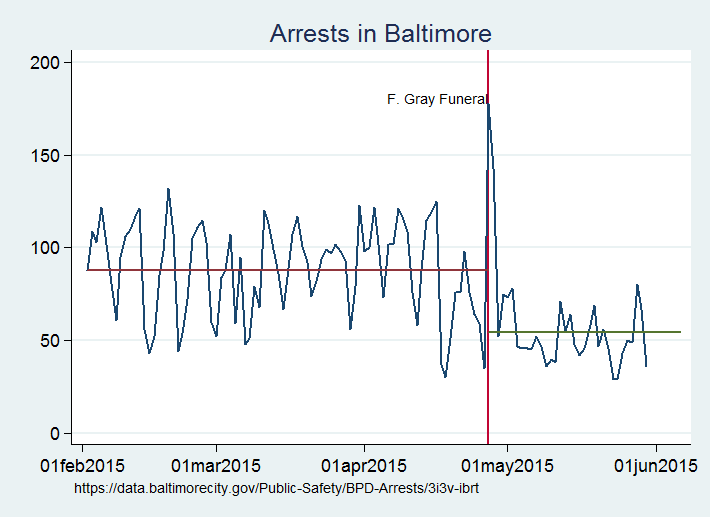
As Peter Moskos argues:
In Baltimore today, several police officers need to respond to situations where formerly one could do the job. This stretches resources and prevents proactive policing.
Not all arrests are good arrests, of course, but the strain is cutting policing across the board and the criminals are responding to incentives. Fewer police mean more crime. As arrests have fallen, homicides, shootings, robberies and auto thefts have all spiked upwards. Homicides, for example, have more than doubled from .53 a day on average before the unrest to 1.35 a day after (up to June 6, most recent data)–this is an unprecedented increase–and the highest homicide rate Baltimore has ever seen.
Put differently, the unrest in Baltimore and subsequent reduction in policing is responsible for roughly twenty “excess” deaths. (so far)
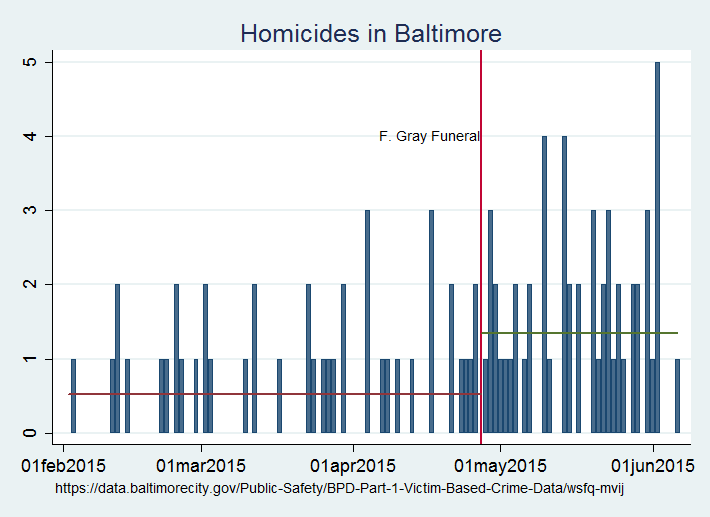
It’s not just homicides, the number of shootings in Baltimore has more than tripled. Shootings increased from .82 a day before the unrest to just over 3 a day. Since the onset of the riots there has hardly been a day without a shooting.
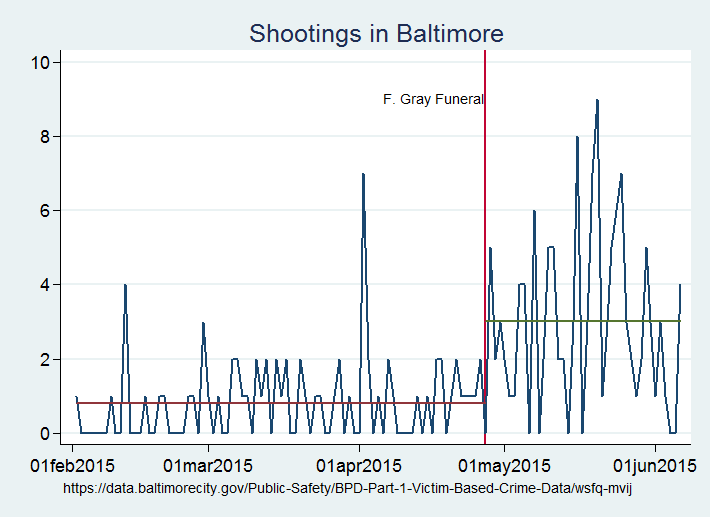
Robberies are up from 8.1 per day to 13.25 per day on average.
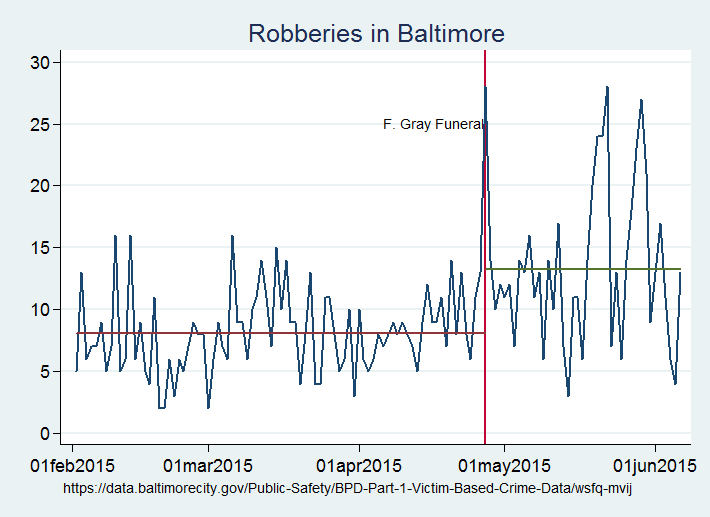
Even auto thefts are up from 9.6 per day to 13.6 per day on average.
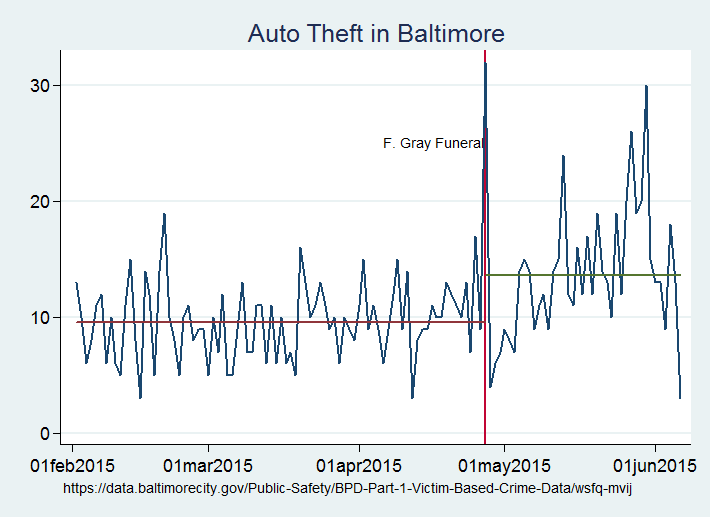
The increase in homicides and other crime is terrible and it is also putting a strain on police resources.
Police Commissioner Anthony W. Batts said the rise in killings is “backlogging” investigators, just as the community has become less engaged with police, providing fewer tips.
With luck the crime wave will subside quickly but the longer-term fear is that the increase in crime could push arrest and clearance rates down so far that the increase in crime becomes self-fulfilling. The higher crime rate itself generates the lower punishment that supports the higher crime rate (see my theory paper). In the presence of multiple equilibria it’s possible that a temporary shift could push Baltimore into a permanently higher high-crime equilibrium. Once the high-crime equilibrium is entered it may be very difficult to exit without a lot of resources that Baltimore doesn’t have. I have long argued that high-crime areas need more police but the tragedy is that they also need high-quality policing and that too is made more difficult to achieve by strained budgets and strained police.